La classificazione dei parquet
Parquet classification
- 21 Ago 2022
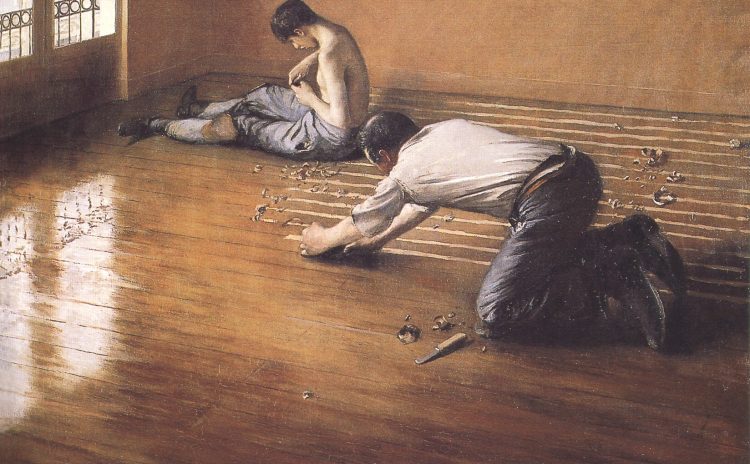
Il parquet, chiamato anche palchetto, è un tipo di pavimentazione composta da legno massiccio di spessore che può variare da 10 a 22 mm o dall’assemblaggio di singoli elementi di legno in cui lo spessore di legno nobile sia superiore o uguale a 2,5 mm, costituiti tutti da legno o suoi derivati.
Le tipologie di parquet, in ordine di qualità crescente, vengono distinte in:
1. LAMINATO
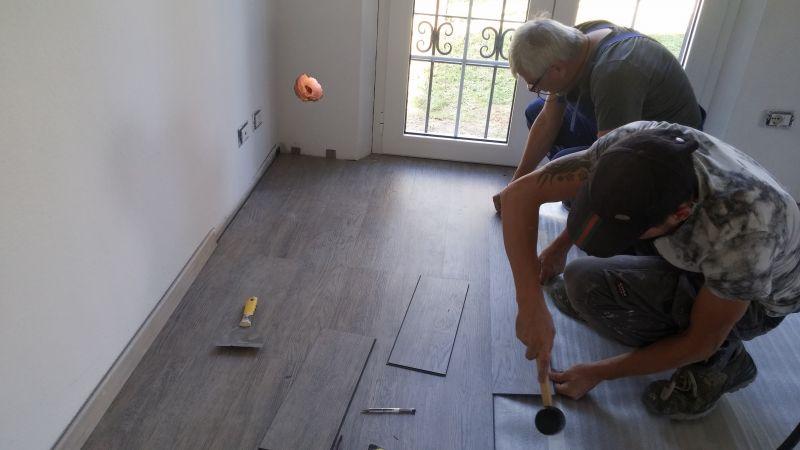
Non si tratta di un vero e proprio parquet ma di qualcosa che gli somiglia molto. Il laminato, in realtà, è composto da fibre di legno tenute insieme da alcune resine e sulla parte superiore vi è applicata un sottile carta stampata che imita il legno. Anche se è composto per la sua maggior parte di legno, non può comunque essere considerato un parquet in piena regola perchè non ha nemmeno un millimetro di strato di legno nobile.
I vantaggi sono:
- Ottima resistenza sia nel tempo sia a fattori come umidità, urti, vapore e infiltrazioni
- Prezzo molto contenuto, ottimo rapporto qualità/prezzo. L’ordine di grandezza è di circa € 60,00 / mq forniti e posti in opera.
- Facilità di pulizia e minor manutenzione rispetto al legno vero
Gli svantaggi sono:
- Non levigabile, per cui non può tornare “come nuovo” dopo anni di utilizzo
- Potere isolante termico ridotto, perchè non è propriamente legno
- Resistenza al calore ridotta, si danneggia a contatto con oggetti bollenti
2. PARQUET PREFINITO o PREDEFINITO
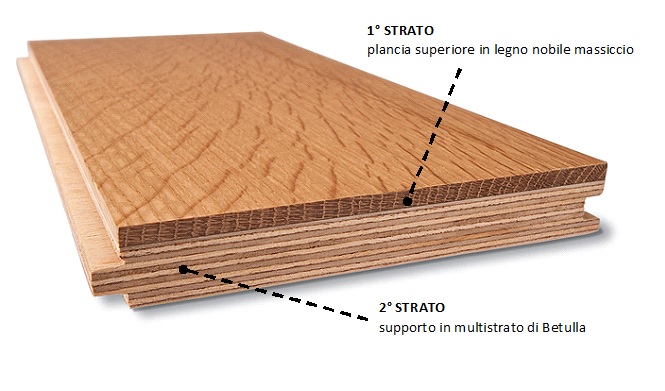
I parquet prefiniti sono molto vantaggiosi dal punto di vista pratico in quanto hanno la caratteristica di essere già verniciati o oliati e subito pronti per essere posati e utilizzati. Vengono realizzati con uno strato superiore di legno nobile, incollato su uno strato di legno povero o di multistrato (il multistrato è composto da una sovrapposizione di fogli di legno sottili, incollati con delle fibre). La posa è rapida, normalmente 20-60 mq/giorno secondo ambiente e tipologia di parquet.
I vantaggi sono:
- Rapido utilizzo: si possono riposizionare i mobili man mano che si prosegue con la posa. Anche la pedonabilità è quasi o del tutto immediata
- Riparabilità: si possono sostituire porzioni di pavimento (anche una singola doga) senza la necessità di levigare l’intero ambiente
- Ripristino: il parquet prefinito, quando lo strato protettivo fosse generalmente deteriorato, può essere ripristinato mediante levigatura o spazzolatura e successivo ritrattamento. Il ripristino in uso abitativo può essere effettuato mediamente ogni 15-40 anni secondo il trattamento
- Stabilità dimensionale: la stabilità dimensionale del parquet prefinito, grazie al metodo costruttivo a più strati, è più elevata rispetto al parquet massello
- Prezzo: prezzi variabili che dipendono dall’essenza, dallo strato nobile, dal metodo costruttivo, dal tipo di venature e dal colore; questi elementi concorrono a rendere il legno più o meno pregiato assieme alla dimensione dei listoni. L’ordine di grandezza è di circa € 100,00 / mq forniti e posti in opera.
- Pulizia: un panno morbido e umido, ad esempio una buona microfibra, e un prodotto detergente specifico sono sufficienti per pulire al meglio il parquet dalle macchie o dagli aloni. Le pulizie più frequenti si fanno mediante appositi panni mangiapolvere.
- Manutenzione: oltre alla normale pulizia del pavimento è necessario utilizzare una tantum dei prodotti protettivi specifici per donare lucentezza e proteggere il pavimento dagli agenti ambientali
Gli svantaggi sono:
- Potere isolante ridotto, per via del poco spessore
- Durata inferiore rispetto al parquet tradizionale, può essere levigato meno volte
- Nessuna possibilità di personalizzazione
3. PARQUET PRELEVIGATO
I parquet prelevigati hanno le stesse caratteristiche costruttive dei parquet prefiniti, sono stati levigati durante le fasi produttive, ma non lucidati.
I vantaggi sono gli stessi dei prefiniti mentre agli svantaggi va aggiunto che necessitano di un trattamento post-posa. L’ordine di grandezza è di circa € 110,00 / mq forniti e posti in opera
4. PARQUET TRADIZIONALE IN MASSELLO
Appartengono a questa categoria tutti i pavimenti in legno realizzati interamente nello stesso legno nobile, senza strati di supporto. Questo significa che è più spesso e che il parquet è ad uno strato solo. La posa del parquet avviene tramite l’incastro dei listoni o incollaggio nelle teste dei listelli in mancanza di incastro, oppure mediante chiodatura negli incastri.
Esistono diversi tipi di parquet tradizionale:
4.1 Parquet Industriale
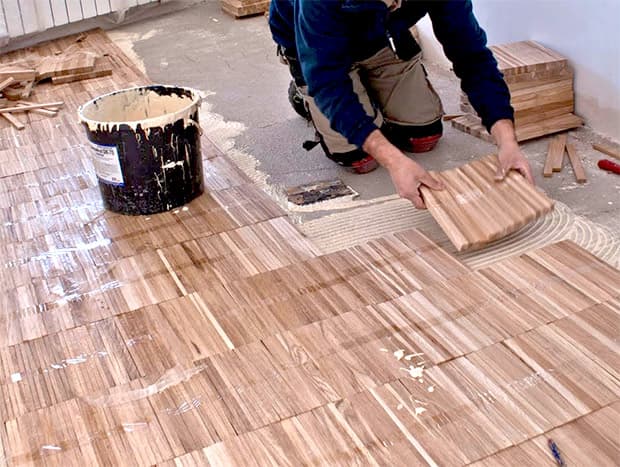
Pensato inizialmente per spazi industriali (da dove ha origine il nome) o commerciali, il parquet industriale è stato ben presto utilizzato per diversi ambienti residenziali in quanto particolarmente resistente. Costituito da lamelle di piccole dimensioni – più strette nella parte a vista, ma con uno spessore maggiore rispetto alla media dei normali pavimenti in legno per interni, unisce un piacevole effetto estetico. Per consentire la posa, gli elementi vengono tenuti saldi da un supporto che può essere una rete, una carta o del particolare nastro adesivo. I supporti verranno rimossi durante la levigatura. Il vantaggio principale di questa tipologia di pavimenti in legno è che sono particolarmente convenienti ed economici. La posa del parquet viene eseguita mediante incollaggio.
I vantaggi sono:
- Caratteristiche del legno: parquet resistente, durevole e robusto (grazie allo spessore e alla compattazione maggiore). Per il parquet industriale sono suggeriti: parquet Rovere, parquet Merbau, parquet in Frassino Termotrattato, parquet in Teak.
- Riparabilità: si possono sostituire porzioni di pavimento (anche pochi listellini), ma è necessario carteggiare e ritrattare un’area più ampia per nascondere la differenza di trattamento.
- Ripristino: il parquet industriale, quando lo strato protettivo fosse generalmente deteriorato, può essere ripristinato mediante levigatura o spazzolatura e successivo ritrattamento. Il ripristino in uso abitativo può essere effettuato mediamente ogni 15-40 anni secondo il trattamento.
- Stabilità dimensionale: la stabilità dimensionale del parquet industriale, grazie alla frammentazione dei listelli, è più elevata rispetto al parquet massello.
- Prezzo: il rapporto qualità/prezzo del parquet industriale è particolarmente interessante. E’ tra i parquet più economici, la lavorazione del legno comporta un numero minore di scarti (è sufficiente comprare solo un 5% in più di parquet grezzo rispetto alla superficie netta). L’unico fattore che può modificare notevolmente i prezzi de parquet industriale è nel caso in cui venga commissionato al posatore una posa complessa, che richiede surplus di tempo e di lavoro. Oggi è superato dal parquet industriale prefinito che consente un’ottima finitura estetica unita alla facilità e velocità di posa. L’ordine di grandezza è di circa € 100,00 / mq forniti e posti in opera
- Pulizia: un panno morbido e umido, ad esempio una buona microfibra, e un prodotto detergente specifico sono sufficienti per pulire al meglio il parquet dalle macchie o dagli aloni. Le pulizie più frequenti si fanno mediante appositi panni mangiapolvere
- Manutenzione: oltre alla normale pulizia del pavimento è necessario utilizzare una tantum dei prodotti protettivi specifici per donare lucentezza e proteggere il pavimento dagli agenti ambientali.
Gli svantaggi sono:
- Presenza di imperfezioni
- Possibile presenza di molti nodi
4.2 Parquet a listelli o listoni da incollare
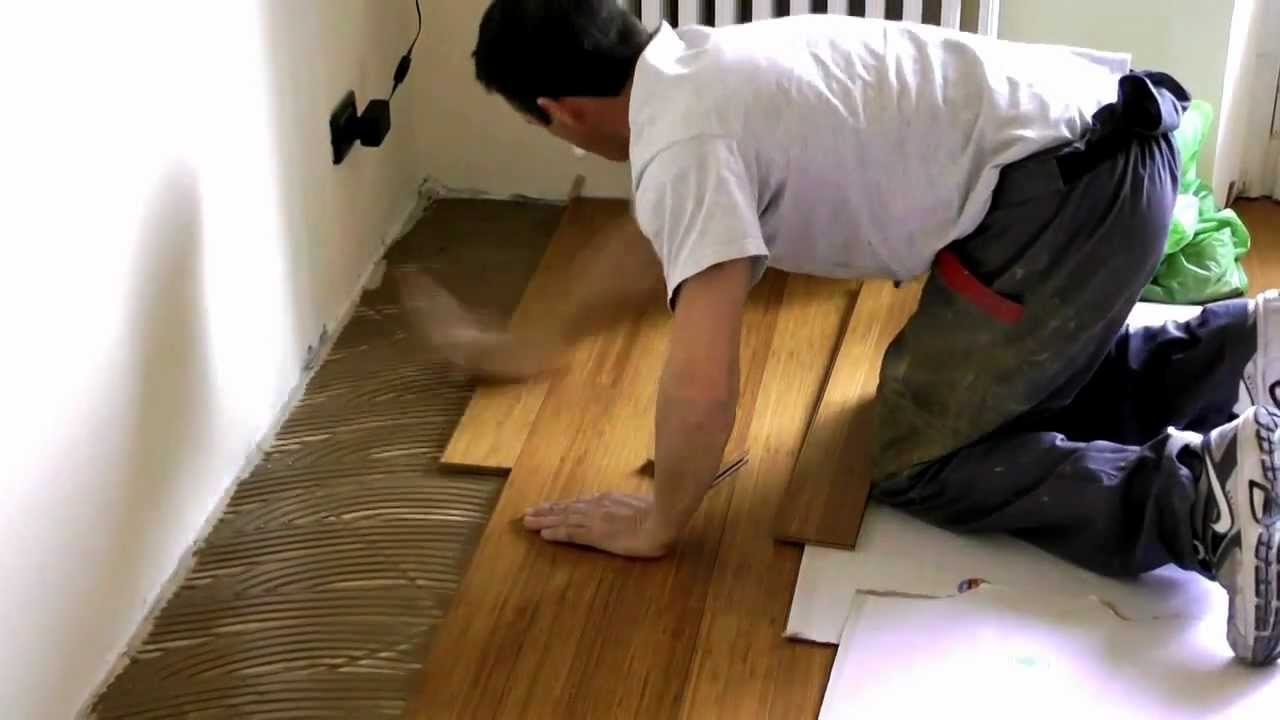
E’ un tipo di pavimento studiato per la posa mediante incollaggio continuo su tutta la superficie. Si può incollare su massetti di cemento, su pannelli di legno, su pavimenti preesistenti in ceramica, marmo o comunque che abbiano una buona compattezza e resistenza a trazione. Sono richiesti tempi di adattamento ambientale dopo la posa che vanno dai 15 giorni in su, secondo la specie legnosa (ad esempio un Faggio necessita di maggior tempo di un Teak) e della tipologia (sono sconsigliati normalmente grandi formati a basso spessore).
I vantaggi sono:
- Caratteristiche del legno: la resistenza e la durata dipendono dalla specie legnosa, dallo spessore, dal rapporto tra larghezza e spessore. Si presta a pose a disegno, a spina e altri tipi.
- Riparabilità: si possono sostituire porzioni di pavimento (anche un listello), ma è necessario carteggiare e ritrattare un’area più ampia per nascondere la differenza di trattamento.
- Ripristino: il parquet massello, quando lo strato protettivo fosse generalmente deteriorato, può essere ripristinato mediante levigatura o spazzolatura e successivo ritrattamento. Il ripristino in uso abitativo può essere effettuato mediamente ogni 15-40 anni secondo il trattamento.
- Stabilità dimensionale: la stabilità dimensionale del parquet massello non è molto elevata, salvo alcune specie legnose che grazie alla loro stabilità ne compensano i limiti.
- Prezzi: il rapporto qualità/prezzo del parquet massello è mediamente interessante. Ciò che caratterizza questi tipi di pavimento sono il costo medio basso della materia (più piccolo è il listello meno costa) e l’effetto legato alla manualità della posa e finitura. L’ordine di grandezza è di circa € 130,00 / mq forniti e posti in opera
- Pulizia: un panno morbido e umido, ad esempio una buona microfibra, e un prodotto detergente specifico sono sufficienti per pulire al meglio il parquet dalle macchie o dagli aloni. Le pulizie più frequenti si fanno mediante appositi panni mangiapolvere.
- Manutenzione: oltre alla normale pulizia del pavimento è necessario utilizzare una tantum dei prodotti protettivi specifici per donare lucentezza e proteggere il pavimento dagli agenti ambientali.
Gli svantaggi sono:
- Necessita di molte cure
- In pratica, ogni 10-15 anni la rilevigatura è d’obbligo
- La messa in posa necessita di un professionista ed è una procedura lunga
4.3 Parquet a listoni da inchiodare o avvitare
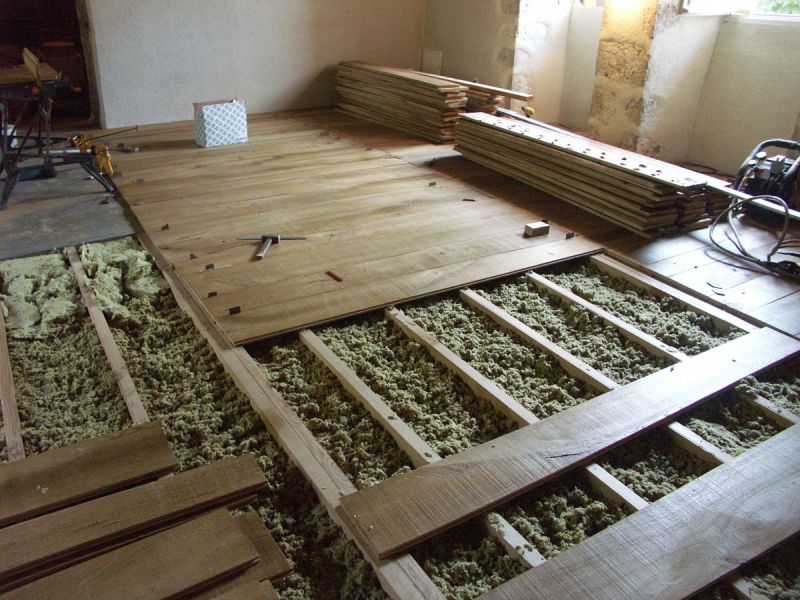
E’ un tipo di pavimento studiato per la posa mediante avvitatura o chiodatura su superfici continue di legno, su telaio o su magatelli annegati nel cemento.
Una peculiarità consiste nello scricchiolìo del parquet stesso, se sollecitato dal camminamento, in particolare se inchiodato. Il legno poi, grazie alla sua elasticità, crea leggere fessure ed imperfezioni casualmente disposte che donano un sapore ed un senso di naturalezza al luogo. I pavimenti in legno antichi sono per la maggior parte realizzati con questa tipologia.
I vantaggi sono:
- Caratteristiche del legno: la resistenza e la durata dipendono dalla specie legnosa, dallo spessore, dal rapporto tra larghezza e spessore. Si presta a pose a disegno, a spina e altri tipi
- Riparabilità: si possono sostituire porzioni di pavimento (anche un listone), ma è necessario carteggiare e ritrattare un’area più ampia per nascondere la differenza di trattamento. E’ necessaria manodopera competente.
- Ripristino: il parquet in listoni da chiodare o avvitare, quando lo strato protettivo fosse generalmente deteriorato, può essere ripristinato mediante levigatura o spazzolatura e successivo ritrattamento. Il ripristino in uso abitativo può essere effettuato mediamente ogni 15-40 anni secondo il trattamento.
- Stabilità dimensionale: la stabilità dimensionale del parquet inchiodato è discreta, considerando la sua capacità di assestarsi se sollecitato. Molto dipende dal verso di posa al fine di ripartirne i movimenti Prezzi parquet inchiodato o avvitato: il prezzo del parquet è mediamente alto, se considerata la struttura sottostante ed i costi di manodopera di buon livello. L’ordine di grandezza è di circa € 170,00 / mq forniti e posti in opera
- Pulizia parquet inchiodato o avvitato: un panno morbido e umido, ad esempio una buona microfibra, e un prodotto detergente specifico sono sufficienti per pulire al meglio il parquet dalle macchie o dagli aloni. Le pulizie più frequenti si fanno mediante appositi panni mangiapolvere.
- Manutenzione parquet inchiodato o avvitato: oltre alla normale pulizia del pavimento è necessario utilizzare una tantum dei prodotti protettivi specifici per donare lucentezza e proteggere il pavimento dagli agenti ambientali.
Gli svantaggi sono:
- Necessita di molte cure
- In pratica, ogni 10-15 anni la rilevigatura è d’obbligo
- Ha un prezzo elevato
- La messa in posa necessita di un professionista ed è una procedura lunga
5. PARQUET SPECIALI
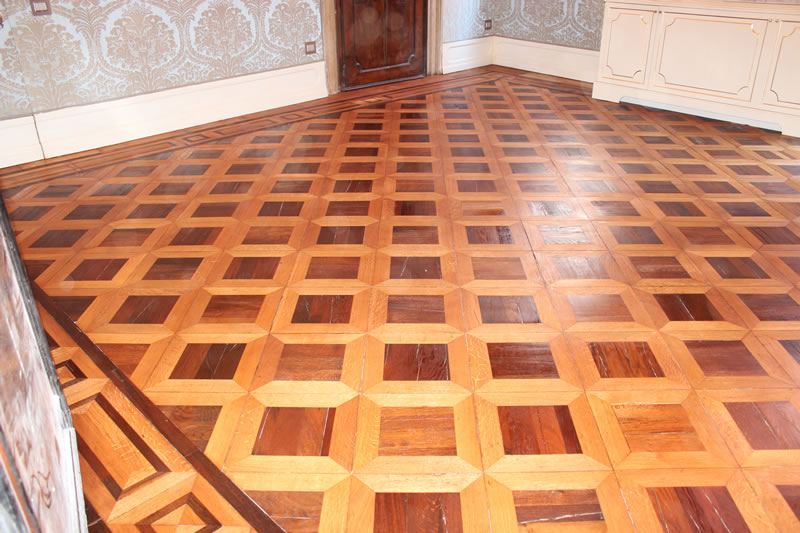
Appartengono a questa categoria tutti i pavimenti in legno di realizzazione non convenzionale, le cui finiture, rapporti dimensionali, combinazioni di posa e disegno non sono assimilabili a nessuna categoria normalmente conosciuta. Questo tipo di soluzione fa si che ogni pavimento sia un esemplare unico.
I parquet speciali sono realizzate sia con materiali artigianali che con sistemi ad alto contenuto tecnologico. Si distinguono in:
5.1 Parquet con legno recuperato, vecchio o antico
Il materiale è ottenuto mediante il recupero di materiale esistente (Travi in legno, vecchi parquet, case smontate, ecc.)
5.2 Parquet a quadri o disegni
Il parquet a quadri o disegno può essere considerato un parquet artistico.
6. PARQUET PER ESTERNO
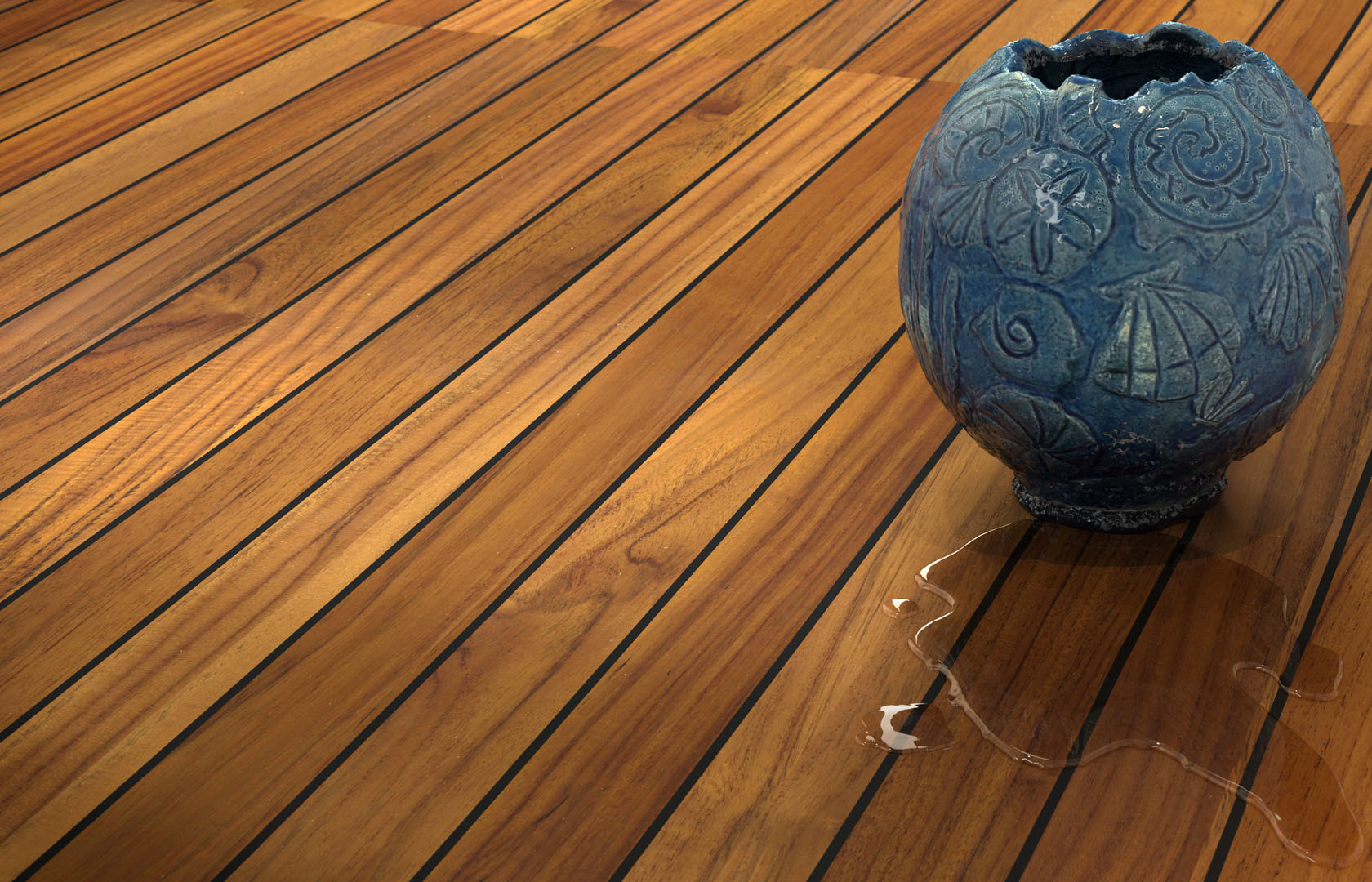
Si tratta di pavimenti in legno adatti ad un uso all’aperto e sottoposti a sollecitazioni estreme (pioggia, sole, vento, ecc). Queste soluzioni consentono l’utilizzo le legno in luoghi esterni, estendendo la dimensione e la fruibilità delle case stesse.
I vantaggi sono:
- Caratteristiche del legno: si utilizzano legni dalle particolari prestazioni per l’uso con forti sollecitazioni (Teak, Accoya, Frassino termotrattato, Pino termotrattato, Mogano, ecc.)
- Riparabilità: si possono sostituire porzioni di pavimento, è richiesta manodopera attrezzata e competente.
- Ripristino: il parquet per esterno, quando lo strato protettivo fosse generalmente deteriorato, può essere ripristinato mediante spazzolatura e successivo ritrattamento. E’ richiesta una manodopera di buona competenza.
- Stabilità dimensionale: la stabilità dimensionale del parquet per esterni è buona, grazie al corretto metodo costruttivo, che compensa correttamente le sollecitazioni ai quali è sottoposto. Malgrado ciò il pavimento in esterno non va confrontato nel comportamento e nel dettaglio con il pavimento in interno.
- Prezzi: il prezzo del parquet per esterni ben costruito varia a seconda del metodo costruttivo e della specie legnosa utilizzata. Ogni lavoro presenta un prezzo differente e personalizzato in funzione delle molte variabili sempre presenti. L’ordine di grandezza è di circa € 220,00 / mq forniti e posti in opera
- Pulizia: uno spazzolone con straccio, e un prodotto detergente specifico sono sufficienti per pulire al meglio il parquet dalle polveri e dallo sporco.
- Manutenzione: oltre alla normale pulizia del pavimento è consigliato utilizzare una tantum dei prodotti protettivi specifici per donare lucentezza e proteggere il pavimento dagli agenti ambientali. Si utilizzano olii specifici ad alta resistenza in esterno.
Gli svantaggi sono:
- Usura per via degli agenti atmosferici quali pioggia, sole e umidità
- Necessità di molta manutenzione, con particolari olii per esterno con densità maggiore quando il clima è molto secco
- Ha un prezzo elevato
- La messa in posa necessita di un professionista ed è una procedura lunga
Troviamo due categorie principali che posseggono caratteristiche tra loro molto differenti: le maxigriglie sono areate e posate orizzontalmente, l’acqua scorre attraverso di esse, raggiungendo poi gli scarichi; il parquet nautico è invece costituito da una superficie continua in leggera pendenza, sopra la quale scorre l’acqua in direzione degli scarichi.
6.1 Parquet in maxigriglie
Una delle migliori soluzioni di pavimentazione in esterno è costituita da speciali griglie di grandi dimensioni (lunghe circa 2 metri) di listoni spaziati tra loro per consentire il passaggio di umidità e acqua, appositamente affrancati nella parte sottostante da traversi sovradimensionati e avvitati con viti inox non visibili.
6.2 Parquet in listoni e clips
I sistemi con fresatura laterale e sistemi di montaggio a clips, hanno invece una imprevedibilità di comportamento alle sollecitazioni esterne, salvo alcuni compositi di ultima generazione che possiedono incastri robusti e finiture innovative.
6.3 Parquet nautico
Una categoria a parte dei pavimenti per esterni sono i pavimenti nautici. Questi pavimenti hanno un alto valore tecnologico e si prestano a sollecitazioni estreme. Sono realizzati in pannelli di grandi dimensioni appositamente gommati in laboratorio. La gommatura consiste in una fresata continua dentro la quale viene alloggiata una speciale gomma che serve a garantire la corretta stabilità del legno, unitamente ad una funzione antisdrucciolo. Una alternativa ai pannelli è costituita dalla posa e gommatura con listoni in massello di specie legnose appropriate, realizzata interamente in opera.
 Arch. Anselmo Santilli – ZEDPROGETTI srl
Arch. Anselmo Santilli – ZEDPROGETTI srl
Parquet is a type of flooring composed of solid wood with a thickness that can vary from 10 to 22 mm or by assembling individual elements of wood in which the thickness of noble wood is greater than or equal to 2.5 mm, all made of wood or its derivatives.
The types of parquet, in order of increasing quality, are divided into:
1. LAMINATE
It’s not a real parquet, it’s something that looks a lot like it. Laminate is actually made of wood fibres held together by a few resins, and a thin printed paper imitating wood is applied to the top. Even if it is mostly made of wood, it cannot be considered as a full-fledged parquet because it does not have a single millimetre of noble wood.
The advantages are:
Very good resistance both over time and to factors such as humidity, impact, steam and infliction
Very low price. The cost is about € 60.00 / square meters provided and installed
Easy cleaning and less maintenance than real wood
The disadvantages are:
Not sandable, so it can’t be “as good as new” after years of use
Reduced thermal insulation power, because it is not properly wood
Reduced heat resistance, damages when in contact with hot objects2. FINISHED PARQUET or FINISHED PARQUET
Prefinished parquet floors are very advantageous from a practical point of view as they have the characteristic of being already painted or oiled and immediately ready to be laid and used. They are made with a top layer of noble wood, glued on a layer of poor wood or plywood (the plywood is composed of an overlap of thin sheets of wood, glued with fibers). Installation is quick, normally 20-60 sqm/day depending on the environment and type of parquet.
The advantages are:
Quick to use: furniture can be repositioned as you continue with the installation. Also the walkability is almost or completely immediate
Reparability: it is possible to replace portions of the floor (even a single slat) without the need to sand the entire room
Restore: the pre-finished parquet, when the protective layer is generally deteriorated, can be restored by sanding or brushing and subsequent reprocessing. The restoration in residential use can be carried out on average every 15-40 years according to the treatment
Dimensional stability: the dimensional stability of pre-finished parquet, thanks to the multi-layer construction method, is higher than that of solid parquet.
Price: variable prices depending on the wood, the noble layer, the construction method, the type of grain and the colour; these elements contribute to make the wood more or less precious together with the size of the planks. The cost is about € 100.00 / square meters provided and installed
Cleaning: a soft and damp cloth, such as a good microfibre, and a specific detergent product are sufficient to clean the parquet from stains or stains. The most frequent cleaning is carried out with special dust-cleaning cloths.
Maintenance: in addition to the normal cleaning of the floor, it is necessary to use one-off specific protective products to give the floor a shiny appearance and protect it from environmental agents.
The disadvantages are:
Reduced insulating power due to low thickness
Less durability than traditional parquet, can be sanded less times
No customization options3. PRE-SANDED PARQUET
Pre-sanded parquet has the same construction characteristics as pre-finished parquet and has been smoothed during the production phases, but not polished.
The advantages are the same as those of the prefinished parquet, while the disadvantages are that they require a post-laying treatment. The cost is about € 110.00 / square meters provided and installed4. TRADITIONAL SOLID WOOD PARQUET
This category includes all wooden floors made entirely of the same noble wood, without supporting layers. This means that it is thicker and that the parquet is single-layer. The laying of the parquet is done by the interlocking of the planks or gluing in the heads of the planks in the absence of interlocking, or by nailing in the interlocking.
There are different types of traditional parquet:4.1 Industrial parquet
Initially designed for industrial (where the name comes from) or commercial spaces, industrial parquet was soon used for various residential environments as it is particularly resistant. Made up of small lamellas – narrower in the visible part, but thicker than the average of normal indoor wooden floors – it combines a pleasant aesthetic effect. To allow the installation, the elements are held firmly by a support that can be a net, a paper or special adhesive tape. The supports will be removed during sanding. The main advantage of this type of wooden floor is that it is particularly economical and economical. The laying of the parquet is carried out by gluing.The advantages are:
Wood characteristics: resistant, durable and sturdy parquet (thanks to its thickness and increased compaction). For industrial parquet we recommend: Oak parquet, Merbau parquet, Thermo-treated Ash parquet, Teak parquet.
Repairable: portions of the floor can be replaced (even a few strips), but it is necessary to sand and retract a larger area to hide the difference in treatment.
Restoration: when the protective layer is generally deteriorated, industrial parquet can be restored by sanding or brushing and subsequent reprocessing. The restoration in residential use can be carried out on average every 15-40 years, depending on the treatment.
Dimensional stability: the dimensional stability of industrial parquet, thanks to the fragmentation of the strips, is higher than that of solid parquet.
Price: the quality/price ratio of industrial parquet is particularly interesting. It is one of the cheapest parquet, the woodworking involves a lower number of waste (just buy a 5% more raw parquet than the net surface). The only factor that can significantly change the prices of industrial parquet is if the installer is commissioned to install a complex installation, which requires extra time and work. Today, it is surpassed by pre-finished industrial parquet that allows for an excellent aesthetic finish combined with ease and speed of installation. The cost is about € 100.00 / square meters provided and installed
Cleaning: a soft, damp cloth, such as a good microfibre, and a specific cleaning product are sufficient to clean the parquet from stains or stains. The most frequent cleaning is carried out with special dust-cleaning cloths.
Maintenance: in addition to normal floor cleaning, it is necessary to use one-off specific protective products to give the floor a shiny appearance and protect it from environmental agents.
The disadvantages are:
Presence of imperfections
Possible presence of many nodes4.2 Parquet with strips or planks to be glued
This type of floor has been designed for installation by means of continuous gluing on the entire surface. It can be glued on cement screeds, on wooden panels, on pre-existing ceramic or marble floors or in any case that have a good compactness and tensile strength. Environmental adaptation times after laying are required, ranging from 15 days upwards, depending on the wood species (for example, a Beech requires more time than a Teak) and the type (large formats with low thickness are not normally recommended).
The advantages are:
Wood characteristics: strength and durability depend on the wood species, the thickness, the ratio between width and thickness. It lends itself to drawing, spine and other types of laying.
Reparability: portions of the floor can be replaced (even a strip), but it is necessary to sand and retract a larger area to hide the difference in treatment.
Restoration: when the protective layer is generally deteriorated, solid parquet can be restored by sanding or brushing and subsequent reprocessing. The restoration in residential use can be carried out on average every 15-40 years, depending on the treatment.
Dimensional stability: the dimensional stability of solid parquet is not very high, except for some wood species which, thanks to their stability, compensate for their limits.
Prices: the quality/price ratio of solid parquet is on average interesting. What characterizes these types of floor are the low average cost of the material (the smaller the listel, the cheaper it costs) and the effect linked to the manual nature of the laying and finishing. The cost is about € 130.00 / square meters provided and installed
Cleaning: a soft, damp cloth, such as a good microfibre, and a specific cleaning product are sufficient to clean the parquet from stains or stains. The most frequent cleaning is carried out by means of special dust-eating cloths.
Maintenance: in addition to the normal cleaning of the floor, it is necessary to use one-off specific protective products to give the floor a shiny appearance and protect it from environmental agents.
The disadvantages are:
It needs a lot of care
In practice, every 10-15 years, sanding is a must.
Laying requires a professional and is a lengthy procedure4.3 Parquet with planks to be nailed or screwed on
It is a type of floor designed for installation by screwing or nailing on continuous wooden surfaces, on a frame or on magatelli embedded in cement.
A peculiarity consists in the creaking of the parquet itself, if stressed by the walkway, in particular if nailed. The wood then, thanks to its elasticity, creates slight cracks and imperfections randomly arranged that give a taste and a sense of naturalness to the place. Antique wooden floors are for the most part made with this type.The advantages are:
Wood characteristics: strength and durability depend on the wood species, the thickness, the ratio between width and thickness. It lends itself to drawing, spine and other types of laying.
Reparability: portions of the floor can be replaced (even a plank), but it is necessary to sand and retract a larger area to hide the difference in treatment. Competent labour is required.
Restore: when the protective layer is generally deteriorated, the parquet in planks to be nailed or screwed on can be restored by sanding or brushing and subsequent reprocessing. The restoration in residential use can be carried out on average every 15-40 years, depending on the treatment.
Dimensional stability: the dimensional stability of the nailed parquet is discreet, considering its ability to settle if stressed. Much depends on the direction of installation in order to distribute its movements Nailed or screw-retained parquet prices: the price of the parquet is on average high, if you consider the underlying structure and good labor costs. The cost is about € 170.00 / square meters provided and installed
Cleaning nailed or screw-retained parquet: a soft, damp cloth, such as a good microfibre, and a specific cleaning product are sufficient to clean the parquet from stains or stains. The most frequent cleaning is carried out with special dust-cleaning cloths.
Maintenance of nailed or screw-retained parquet: in addition to the normal cleaning of the floor, it is necessary to use one-off specific protective products to give the floor a shiny appearance and protect it from environmental agents.
The disadvantages are:
It needs a lot of care
In practice, every 10-15 years, sanding is a must.
It has a high price
Laying requires a professional and is a lengthy procedure5. SPECIAL PARQUET
This category includes all non-conventional wooden floors, whose finishes, dimensional ratios, laying and design combinations are not comparable to any normally known category. This type of solution makes each floor unique.
Special parquet floors are made with both handcrafted materials and high-tech systems. They are divided into:5.1 Parquet with recovered wood, old or old
The material is obtained through the recovery of existing material (wooden beams, old parquet, demounted houses, etc.).5.2 Checked or patterned parquet
Checked or patterned parquet can be considered as artistic parquet.6. OUTDOOR PARQUET
These are wooden floors suitable for outdoor use and subject to extreme stresses (rain, sun, wind, etc.). These solutions allow the use of wood in outdoor areas, extending the size and usability of the houses themselves.
The advantages are:
Wood characteristics: wood with special performances is used for use with strong stresses (Teak, Accoya, Thermo-treated Ash, Thermo-treated Pine, Mahogany, etc.).
Reparability: portions of the floor can be replaced, equipped and competent labour is required.
Restore: outdoor parquet, when the protective layer is generally deteriorated, can be restored by brushing and subsequent reprocessing. A skilled workforce is required.
Dimensional stability: the dimensional stability of outdoor parquet is good, thanks to the correct construction method, which correctly compensates for the stresses to which it is subjected. Despite this, the outdoor floor should not be compared in its behaviour and detail with the indoor floor.
Prices: The price of well-constructed outdoor parquet varies depending on the construction method and the wood species used. Each job has a different price and customized according to the many variables always present. The cost is about € 220.00 / square meters provided and installed
Cleaning: a brush with a cloth and a specific cleaning product are sufficient to clean the parquet from dust and dirt.
Maintenance: in addition to normal floor cleaning, it is recommended to use one-off specific protective products to give the floor a shiny appearance and protect it from environmental agents. Specific oils with high resistance are used outdoors.
The disadvantages are:
Wear due to atmospheric agents such as rain, sun and humidity
A lot of maintenance is needed, with special outdoor oils with higher density when the climate is very dry
It has a high price
Laying requires a professional and is a lengthy procedureThere are two main categories that have very different characteristics: the maxi-grids are ventilated and laid horizontally, the water flows through them, then reaching the drains; the nautical parquet instead consists of a continuous surface on a slight slope, above which flows the water in the direction of the drains.
6.1 Parquet in maxi grills
One of the best outdoor flooring solutions consists of special large grids (about 2 meters long) of planks spaced out to allow the passage of moisture and water, specially freed in the lower part by oversized crosspieces and screwed with invisible stainless steel screws.6.2 Parquet in planks and clips
The systems with side milling and clip mounting systems, on the other hand, have an unpredictable behavior to external stresses, except for some composites of the latest generation that have strong joints and innovative finishes.6.3 Nautical parquet
A separate category of outdoor flooring is nautical flooring. These floors have a high technological value and are suitable for extreme loads. They are made of large panels specially rubberized in the laboratory. The rubberizing consists of a continuous milled inside which is housed a special rubber that serves to ensure the correct stability of the wood, together with an anti-slip function. An alternative to the panels is the installation and rubberizing with solid wood planks of appropriate species, carried out entirely on site.

